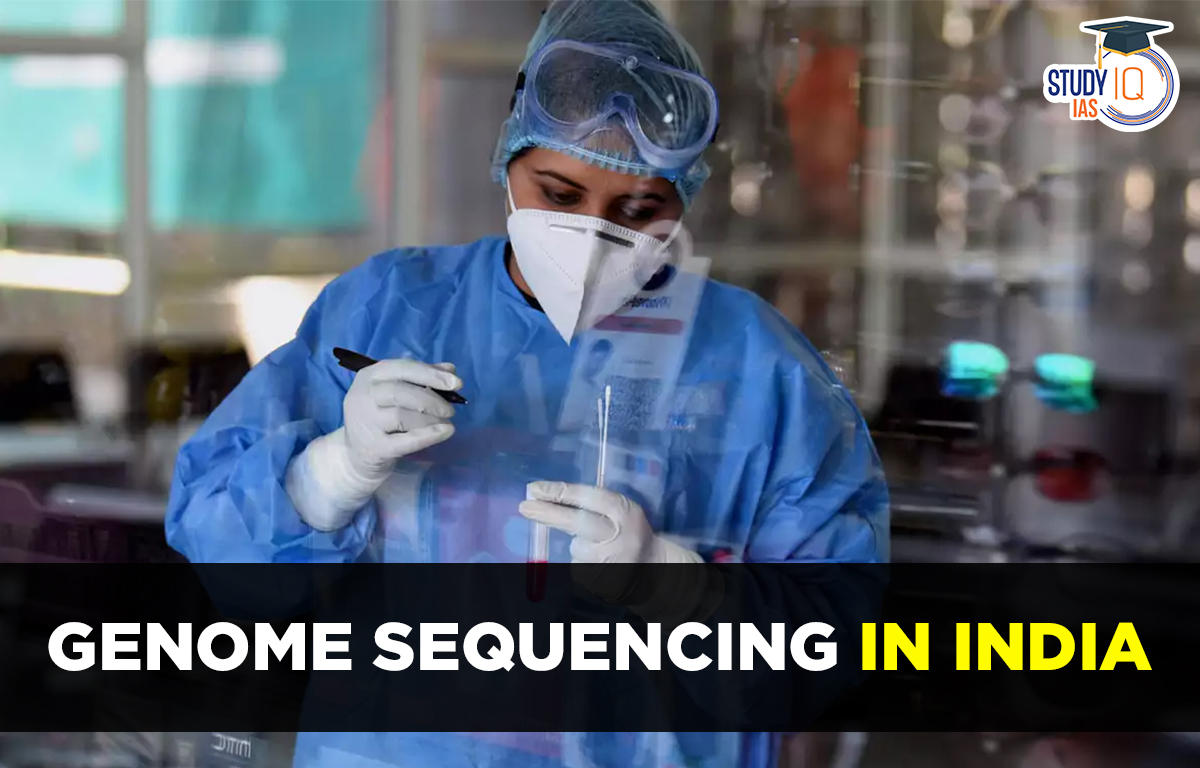Table of Contents
Context: The Department of Biotechnology recently said that the exercise to sequence 10,000 Indian human genomes and create a database under the Centre-backed Genome India Project is about two-thirds complete.
What is Genome?
- A genome is all of the genetic material in an organism.
- It is made of DNA (or RNA in some viruses) and includes genes and other elements that control the activity of those genes.
- Genome v/s Gene: Genome is the entire set of genetic material or DNA, while gene is a specific segment of DNA that codes for a particular protein or RNA molecule.
- Human genome:
- The human genome is the entire set of deoxyribonucleic acid (DNA) residing in the nucleus of every cell of each human body.
- The DNA consists of a double-stranded molecule built up by four bases – adenine (A), cytosine (C), guanine (G) and thymine (T). Every base on one strand pairs with a complementary base on the other strand (A with T and C with G).
- In all, the genome is made up of approximately 3.05 billion such base pairs.

What is Genome Sequencing?
- Genome sequencing is figuring out the order of DNA nucleotides, or bases, in a genome—the order of Adenine, Cytosine, Guanines, and Thymine that make up an organism’s DNA.
- While the sequence or order of base pairs is identical in all humans, compared to that of a mouse or another species, there are differences in the genome of every human being that make them unique.
Methods of Genome Sequencing
- Major genome sequencing methods are the clone-by-clone method and the whole genome shotgun sequencing.
- The clone-by-clone method:
- It involves constructing a physical map of the genome by cutting the DNA into small fragments, cloning these fragments into bacterial or yeast artificial chromosomes (BACs or YACs), and then mapping the location of each fragment within the genome.
- The DNA in each BAC or YAC clone is then sequenced, and the sequences are assembled to reconstruct the entire genome.
- It works well for larger genomes like eukaryotic genomes but it requires a high-density genome map.
- The whole genome shotgun sequencing method:
- It involves randomly fragmenting the genome into small pieces, sequencing each piece, and then using computational algorithms to assemble the sequences into a complete genome.
- This method was made possible by the development of high-throughput sequencing technologies, such as next-generation sequencing, which can generate large amounts of sequence data rapidly and inexpensively.
- It is a faster method of sequencing but is not suitable for larger genomes like eukaryotic genomes as they have a number of repetitive DNA sequences in which the assembling process is challenging.
Applications of Genome Sequencing?
- Disease risk assessment: Genomic sequencing can identify genetic variants associated with increased risk of certain diseases, such as breast cancer or Alzheimer’s disease.
- Genome sequencing has been used to evaluate rare disorders, preconditions for disorders, even cancer from the viewpoint of genetics, rather than as diseases of certain organs.
- Nearly 10,000 diseases — including cystic fibrosis and thalassemia — are known to be the result of a single gene malfunctioning.
- Ancestry tracing: Genomic sequencing can provide information about an individual’s ancestry and genetic heritage.
- Cancer diagnosis: Liquid biopsies, where a small amount of blood is examined for DNA markers, could help diagnose cancer long before symptoms appear.
- Halting disease transmission: In public health, however, sequencing has been used to read the codes of viruses—
- For Example: One of its first practical usages was in 2014, when a group of scientists from M.I.T and Harvard sequenced samples of Ebola from infected African patients to show how genomic data of viruses could reveal hidden pathways of transmission, which might then be halted, thus slowing or even preventing the infection’s spread.
- Also, during the COVID-19 pandemic, genomic sequencing helped to identify the virus, track its spread, identify new variants, understand how the virus spreads, and develop vaccines.
- Pharmacogenomics: Genomic sequencing can identify genetic variants that affect an individual’s response to certain medications.
What are the concerns associated with Genomic Sequencing?
- Privacy concerns: As genomic sequencing involves the collection and analysis of genetic data, there are concerns about privacy and the potential misuse of this information.
- High Costs: Genomic sequencing can be expensive, which can limit access to this technology for some patients or researchers.
- Misuse: There is a risk that genomic sequencing data could be used for nefarious purposes, such as genetic discrimination or targeting of individuals based on their genetic profile.
- Psychological impact: Knowing one’s genetic risk factors can have a psychological impact, including increased anxiety or depression. Individuals may also face stigma or discrimination based on their genetic risk factors.
- Data interpretation and accuracy: Errors in data interpretation or analysis could lead to incorrect diagnoses or treatment decisions.
About the Genome India Project
- It is a government-led initiative launched in 2019 that aims to sequence the genomes of over 10,000 Indians from diverse socio-economic, geographical and linguistic backgrounds to create a comprehensive genomic database of the Indian population.
- The project involves about 20 institutions across India and with analysis and coordination done by the Centre for Brain Research at IISc, Bangalore.
- Significance of the project:
- India’s 1.3 billion-strong population consists of over 4,600 population groups, many of which are endogamous. Thus, the Indian population harbours distinct variations, with disease-causing mutations often amplified within some of these groups. Creating a database of Indian genomes allows researchers to learn about genetic variants unique to India’s population groups and use that to customize drugs and therapies.
- The project will also help “unravel the genetic underpinnings of chronic diseases currently on the rise in India, (for) example, diabetes, hypertension, cardiovascular diseases, neurodegenerative disorders, and cancer”.
Other Initiatives by the Government
| Indian Genome Variation Consortium | It is a network of researchers and institutions that are working to map the genetic variation in the Indian population and understand its implications for health and disease. |
| Genome Valley 2.0 | Genome Valley 2.0 is a project aimed at creating a genomic database of the Indian population and developing personalized healthcare solutions. It is a joint initiative between the government of Telangana and several research institutions and companies. |
| IndiGen | IndiGen programme aims to undertake whole genome sequencing of thousands of individuals representing diverse ethnic groups from India. The objective is to enable genetic epidemiology and develop public health technologies applications using population genome data. |


 India China Trade Deficit, India’s imp...
India China Trade Deficit, India’s imp...
 Current Affairs 29th April 2024 for UPSC...
Current Affairs 29th April 2024 for UPSC...
 Towards Green Growth, Impact of Climate ...
Towards Green Growth, Impact of Climate ...

















